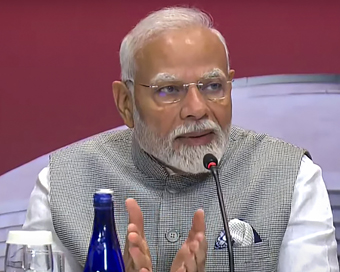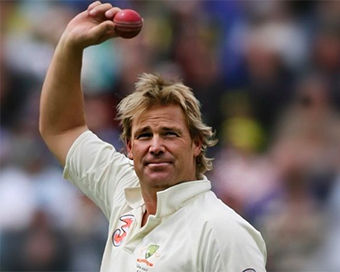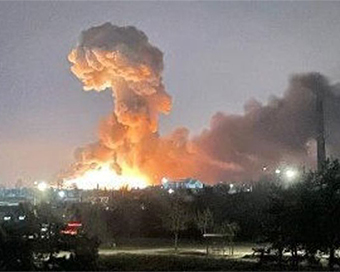 PM Modi visit USA
PM Modi visit USA Only the mirror in my washroom and phone gallery see the crazy me : Sara Khan
Only the mirror in my washroom and phone gallery see the crazy me : Sara Khan Karnataka rain fury: Photos of flooded streets, uprooted trees
Karnataka rain fury: Photos of flooded streets, uprooted trees Cannes 2022: Deepika Padukone stuns at the French Riviera in Sabyasachi outfit
Cannes 2022: Deepika Padukone stuns at the French Riviera in Sabyasachi outfit Ranbir Kapoor And Alia Bhatt's Wedding Pics - Sealed With A Kiss
Ranbir Kapoor And Alia Bhatt's Wedding Pics - Sealed With A Kiss Oscars 2022: Every Academy Award Winner
Oscars 2022: Every Academy Award Winner Shane Warne (1969-2022): Australian cricket legend's life in pictures
Shane Warne (1969-2022): Australian cricket legend's life in pictures Photos: What Russia's invasion of Ukraine looks like on the ground
Photos: What Russia's invasion of Ukraine looks like on the ground Lata Mangeshkar (1929-2022): A pictorial tribute to the 'Nightingale of India'
Lata Mangeshkar (1929-2022): A pictorial tribute to the 'Nightingale of India' PM Modi unveils 216-feet tall Statue of Equality in Hyderabad (PHOTOS)
PM Modi unveils 216-feet tall Statue of Equality in Hyderabad (PHOTOS)Hockey India has announced a 54-member core probable squad for the upcoming senior men’s
- Satwik-Chirag return as BAI names 14-strong squad for BWF Sudirman Cup Finals 2025
- Men’s Sr Hockey Nationals to be played in division-based format from April 4
- Mensik denies Djokovic 100th title in Miami final
- KIPG: Son of a vegetable vendor, Bihar’s Jhandu Kumar eyes Worlds, 2028 Paralympics
- Hardik Singh credits hard work and team unity for receiving HI Midfielder of the Year award
January inflation eases to 5.07%, December IIP lower at 7.1% Last Updated : 12 Feb 2018 11:57:31 PM IST 
New Delhi: ASSOCHAM President Sandeep Jajodia addresses a press conference in New Delhi on Feb 22, 2017. Also seen ASSOCHAM Secretary General DS Rawat.
A slight easing of food prices helped lower India's retail inflation in January to 5.07 per cent even as factory production growth slowed somewhat in December to 7.1 per cent, according to official data on Monday.
India Inc lauded the continuing high single-digit recovery in industry as well as the slight fall in inflation.
While retail inflation was 5.21 per cent in December 2017, the Index of Industrial Production (IIP) had grown at an impressive 8.8 per cent in November.
On a year-on-year basis, the consumer price index (CPI) last month was at a much higher level than the 3.17 per cent in January 2017.
The consumer food price index (CFPI) in January stood at 4.58 per cent compared with the 4.85 per cent of December 2017.
As per the data released by the Central Statistics Office (CSO), the sequential slowdown in factory output was mainly on account of lower production in the manufacturing sector.However, on a year-on-year basis, the manufacturing sector expanded by a healthy 8.4 per cent, while the mining sector's output inched up by 1.2 per cent and the sub-index of electricity generation increased by 4.4 per cent.
"In terms of industries, 16 out of the 23 industry groups in manufacturing sector have shown positive growth during December 2017 compared with corresponding month of the previous year," the CSO said.
According to the data, the industry group 'manufacture of other transport equipment' has shown the highest growth of 38.3 per cent followed by 33.6 per cent in 'manufacture of pharmaceuticals, medicinal chemicals and botanical products' and 29.8 per cent in 'manufacture of computers, elecronic and optical products'.
Last week, The Reserve Bank of India (RBI) kept its key interest rate unchanged at 6 per cent for the third time in succession at its final bi-monthly monetary policy review of the fiscal, citing upside risks for inflation from rising global crude oil prices and other domestic factors.
The RBI said its decision to keep its repo rate, or short-term lending rate for commercial banks, unchanged is consistent with the neutral stance of the central bank aimed at achieving its median inflation target of 4 per cent.
"We expect headline inflation to be at 5.1 per cent in the fourth quarter (January-March), including the impact of HRA (house rent allowance) to central employees, up from the 4.6 per cent in Q3," RBI Governor Urjit Patel told reporters in Mumbai after the release of the monetary policy review.
However, the fact that the central bank did not raise the repo rate in the face of hardening inflation as recommended by one of the six monetary policy committee (MPC) members is being considered as an attempt to aid in economic recovery.
Industry chamber Assocham termed the IIP data "a positive sign towards growth cycle of industrial activity in India".
"However, risks to the Indian economy continues to prevail in the forms of continued uncertainties in the global environment due to geo-political situations, including rising global protectionism could further delay a meaningful recovery of external demand," said Assocham President Sandeep Jajodia.
"Besides, private investment continues to face several impediments in the form of corporate debt overhang, stress in the financial sector, where (banks') NPAs (non-performing assets) continue to increase, excess capacity and regulatory and policy challenges," he added.
"This is the second consecutive month in which IIP has shown high single-digit growth, which is encouraging," India Ratings and Research (Ind-Ra) Principal Economist Sunil Kumar Sinha said in a statement.
"However, Ind-Ra believes it still early to read much from these numbers as these have been calculated on a low base when industrial output had collapsed due to the impact of demonetisation," he said.
"Retail inflation came down to 5.07 per cent in January 2018, lower than 5.21 per cent recorded last month, but remained higher than the RBI's base target value of 4 per cent," he added.
Rating agency Crisil said that inflation, however, continued to firm up in large parts of the services sectors such as housing, driven by the revision in house rent allowance payments, education and in recreation, amusement and personal care and effects.
"Yet, core inflation, stayed broadly unchanged from the previous month, at around 5.1 per cent in January," a Crisil release said.
"The industry seems to be shedding away the weight of GST-related glitches behind and trying to get back lost momentum, as both domestic and global growth surge."IANS For Latest Updates Please-
Join us on
Follow us on








172.31.16.186







